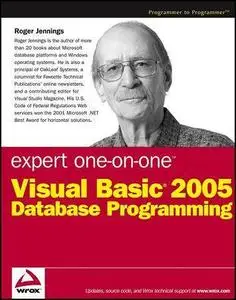Roger Jennings, "Expert One-on-One Visual Basic 2005 Database Programming"
Wrox | Dec 2005 | ISBN: 076457678X | English | 624 pages | PDF | 16 MB (book + source code)
This book is intended for experienced VB programmers who are upgrading from VB6 or VS 2002/2003 to VB 2005. Basic familiarity with the VS 2005 integrated development environment (IDE) is assumed. However, no prior VB6, VBA, or VBScript database programming experience is necessary, except for Chapter 1, iMigrating from ADO to ADO.NET.î Some experience with writing Micro$oft Transact-SQL (T-SQL) statements and authoring simple stored procedures is expected. Familiarity with XML1.0 and XMLschemas will aid your understanding of DataSets and SQLServer 2005's new xml datatype. Some experience with writing XPath 1.0 expressions will be helpful to get the most benefit from Chapter 12, iExploring the xml Datatype.î
One-on-One Expert Visual Basic 2005 Database Programming concentrates on programming the .NET Framework 2.0's System.Data namespace, which implements ADO.NET 2.0 and related namespaces, such as System.Transactions and System.Xml. The book isn't a new user's guide to the .NET Framework, VS 2005, VBX, or VB 2005; it's devoted entirely to data-related topics.
This book is divided into four parts of three chapters each. Most chapters build on the knowledge you've gained from preceding chapters. Thus, it's recommended that you work your way through the chapters sequentially. Following is a brief description of the parts and their chapters' contents.
TABLE OF CONTENT:
Chapter 01 - Migrating from ADO to ADO.NET
Chapter 02 - Introducing New ADO.NET 2.0 Features
Chapter 03 - Adopting Best Practices for Data-Centric Projects
Chapter 04 - Programming TableAdapters, BindingSources, and DataGridViews
Chapter 05 - Adding Data Validation and Concurrency Management
Chapter 06 - Applying Advanced DataSet Techniques
Chapter 07 - Working with ASP.NET 2.0 DataSources and Bound Controls
Chapter 08 - Applying Advanced ASP.NET 2.0 Data Techniques
Chapter 09 - Publishing Data-Driven Web Services
Chapter 10 - Upgrading from SQL Server 2000 to 200
Chapter 11 - Creating SQL Server Projects
Chapter 12 - Exploring the XML Data Type
>> Download here <<
password:
ganelon



